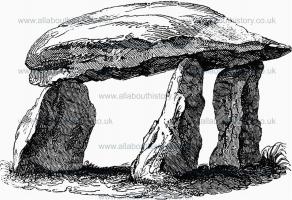Text this colour links to Pages. Text this colour links to Family Trees. Place the mouse over images to see a larger image. Click on paintings to see the painter's Biography Page. Mouse over links for a preview. Move the mouse off the painting or link to close the popup.
Magna Britannia Volume 4 is in Magna Britannica.

1807 The cromlech [Drewsteighton Cromlech aka Spinsters' Rock, Devon [Map]] at Drewe's Teignton, of which much has been said and written, has been supposed by some to have been the sepulchre of an arch-druid: that it was sepulchral there is little doubt; and from the rarity of such monuments, it is most probable that it was for some eminent person; but there is no more reason for supposing that it had any thing to do with druidism, than that the name of Drewe's Teignton was derived from that source.1 This cromlech is on a tenement called Shilston. It is of moor-stone, about 12 feet in length, and about nine feet wide in the widest part. The supporting stones are from six feet to six feet and a half to the under part of the covering stone.
The sketch beneath is from an accurate drawing, made by my brother, in 1807.
Note 1. See "Cornwall," General History, p. clxxxii. clxxxiv. and ccxvii., on the subject of Logan stones and rock basins, and p. 493. of this volume, as to the name of Drewe's Teignton; to which may be added, that there is no authority whatever for the place having been so called before the time of Drewe de Teignton. The natural excavations called Rock basins, occur in numerous places on the granite rocks of Dartmoor, &c. The most celebrated Logan stone in Devon is that on the banks of the Teign, in the parish of Drewe's Teignton; but I am informed that the motion is now scarcely perceptible. A natural pile of rocks in the parish of Manaton, called Bowerman's Nose, somewhat resembling the Cheesewring near Alternon, in Cornwall, has, by some enthusiasts in druidism, been supposed to have been a rock-idol.